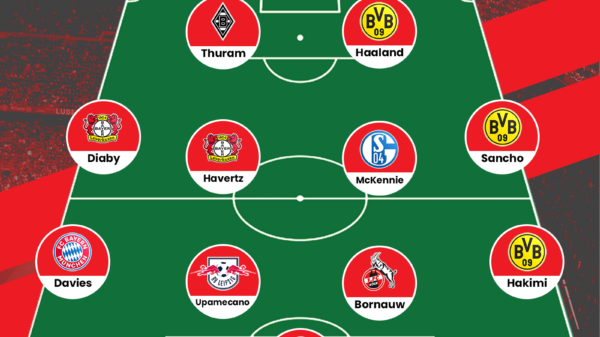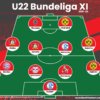James Sutherland writes a detailed tactical analysis about Liverpool’s thrilling win over Borussia Dortmund in the UEFA Europa League quarter final.
Dortmund and Liverpool faced off in the second leg of the Europa League quarterfinals in undoubtedly the pick of the draw. The game proved to be one of the most thrilling and interesting games of the whole season as Liverpool managed to score 3 goals in under 30 minutes to knock out Dortmund. Jurgen Klopp and Thomas Tuchel both coached excellent games, although it was Klopp who eventually got the better of Tuchel, enabling Liverpool to complete its comeback and win the tie.
Liverpool 4-3 Dortmund
Lineups

Made using Tactical Pad
Liverpool (4-2-3-1): Mignolet; Moreno, Sakho, Lovren, Clyne; Can, Milner; Coutinho, Firmino, Lallana; Origi
Dortmund (4-2-3-1): Weidenfeller; Schmelzer, Hummels, Sokratis, Piszczek; Weigl, Castro; Reus, Kagawa, Mkhitaryan; Aubameyang
Dortmund’s Early Control
The game started with Dortmund eschewing a high press for defending in a lower block in their own half. Dortmund shifted from a 4-2-3-1 to a 4-4-2 in defense, with Mkhitaryan and Reus dropping into the midfield, and Kagawa pushing alongside Aubameyang.
This gave Dortmund good control of the center of the field early in the game. Because of their decent horizontal compactness, Liverpool was forced to the wings. They couldn’t build offense through midfield, and instead had to settle for trying to get combinations between Coutinho and Lallana on their respective wings.
Dortmund was also in a good shape to counter attack, which they used to score two early goals. They were able to draw Liverpool into traps, especially in the half spaces and the wings, where they could overload the ball.
With both Mkhitaryan and Reus on the wings, often winning the balls back themselves, Dortmund also cut out the middle man. Their counters were faster and more deadly because Mkhitaryian and Reus already had the ball at their feet, instead of waiting for a winger or fullback to win the ball and then get it to them.
Aubameyang’s speed killed Sakho and Lovren early on as well. He was consistently able to find space running in the half spaces or between the two center backs, and with both Can and Milner often upfield helping with the attack, Lovren and Sakho had little cover for Aubameyang.
This formation did present some problems though. Liverpool was able to find overloads on the wings, especially as the first half went on. Both Reus and Mkhitaryian were focused on Liverpool’s fullbacks, as well as the center of the field, and left space behind them and on their sides.
Liverpool would often play the ball into the center or a halfspace, where the carrier would be closed down by the midfielder and a winger. They would then quickly shift the ball around to the wing, where a fullback and wide midfielder were often already stationed. Liverpool would then have a 2 v. 1 on Dortmund’s fullback.
Above you can see such an example. Liverpool played a long ball out of the middle to Clyne on the wing, where Lallana was able to get behind Reus. This created a 2 v. 1 for Liverpool, leading to an Origi shot on target.
Weigl and Castro had horizontal compactness issues as well, as can be seen in the original photo. Both would often step out of the midfield bank to track Firmino, Lallana or Coutinho trying to drop into space. But this would leave space in front of the backline for one of the other attacking midfielders or Origi to step into. Klopp would exploit this to greater effect later in the match.
They also were never close enough to one another to stop the ball into the middle, although Liverpool would only exploit this later in the match.
Klopp’s Midfield Shift
Coming out of halftime, Klopp made a key tactical shift in midfield that would tip the balance in favor of Liverpool.
Klopp sought to gain greater control of midfield, by pushing the two wide attacking midfielders infield, creating a narrow 4-2-3-1. This was successful, with Liverpool pulling one goal back just minutes after the restart. But after Dortmund’s third goal just before the hour mark, Klopp knew he needed to make a full change.
He brought on Daniel Sturridge and Joe Allen for Firmino and Lallana. Liverpool shifted from the 4-2-3-1 to a 4-4-2, with a diamond in the midfield.
You can see above the midfield diamond. Can is at the base, playing in the pivot, with Milner and Allen on the wings of the diamond, sitting in the half spaces. Coutinho has moved into the 10 space, on top of the diamond.
This shift to a narrow diamond led to Liverpool’s domination for several reasons.
Firstly, it allowed Liverpool to overload Dortmund’s midfield. With Coutinho and Can in the middle, Allen and Milner in the half spaces, and Moreno and Clyne overlapping on the wings, Dortmund’s midfield simply didn’t have the numbers to keep good control of the center. Plus, with the addition of Liverpool’s second striker in Sturridge, both Sokratis and Hummels had to stay in the backline watching Origi and Sturridge. So Castro and Weigl couldn’t expect help from behind.
This numerical superiority led to increased opportunity for passing combinations, seen most clearly in Coutinho’s goal.
Notice the constant movement of the players off the ball: Sturridge dropping into midfield to open up a passing option, Can and Milner cutting off their passes, Coutinho lunging one way and then stepping back into open space. This movement, seemingly pointless, drew Dortmund out and eventually opened room for Coutinho to turn in the half space. Milner’s brilliant run behind Dortmund’s midfield opened the one-two combination up, and Coutinho finished the goal beautifully.
The diamond also helped shore up Liverpool’s counterpress. The midfield was in a much better position to stop Dortmund’s counters, especially considering the compactness Dortmund played with in the second half.
By sacrificing width, Liverpool actually created more offensive chances and a stronger defense. This shift to the midfield diamond is really what won them the game.
Conclusion
Liverpool finished off the miraculous win with two brilliant set pieces. The first, off a corner, saw Daniel Sturridge make a front post run, distracting Dortmund’s defense, while Sakho stepped into the empty space in the middle of the box and put an easy shot in.
The second was a clever move by Sturridge again, as he made a run to get a free kick short. Milner then made a run past several Dortmund players to get the ball on the touchline. By the time he had crossed the ball back across goal, it was over. Hummels was outside the box, and with both Lovren and Sakho up, Dortmund couldn’t deal with the height. Lovren easily headed the ball home.
For Liverpool, this will go down as one of their classic wins. They fully deserved the win, and Jurgen Klopp should take note of what worked in the game.
Dortmund will obviously be incredibly disappointed by the result. They had a serious chance to win the competition, and to collapse in the fashion they did is never good. Tuchel, however, has really transformed the club this season, and even facing the potential sale of several key players Dortmund has much to be optimistic about.
Written by James Sutherland
- Tactical Analysis: Sevilla 2-1 Real Madrid | Sevilla finally end the unbeaten streak - January 21, 2017
- Tactical Analysis: Borussia Dortmund 8-4 Legia Warsaw | Defence thrown out of the windows - November 27, 2016
- Tactical Analysis: RB Leipzig 1-0 Borussia Dortmund | Leipzing outpress Dortmund - September 18, 2016





























































